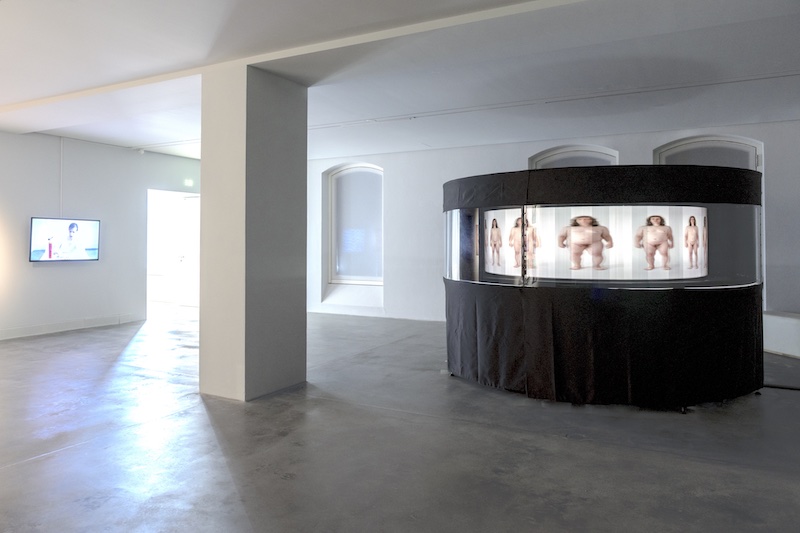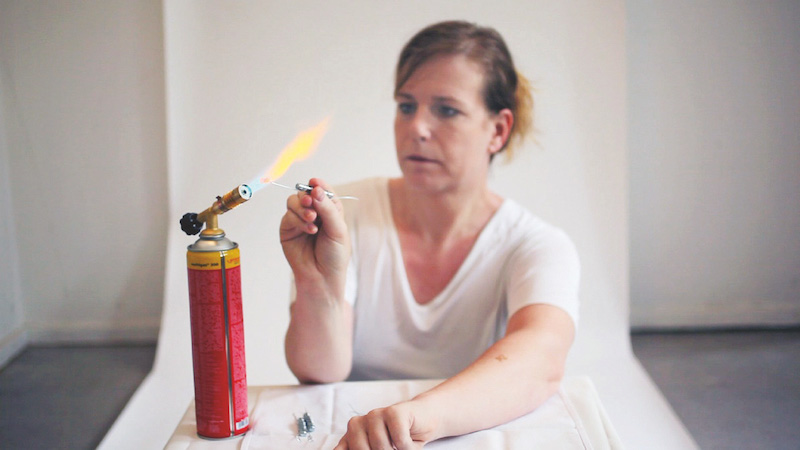by Annalisa Giacinti // Mar. 17, 2023
“A simultaneously sensual, resistant and vulnerable organ” is how curators Julie August and Katharina Koch view skin. It’s the starting point of the artistic analysis carried out in their current exhibition ‘SKIN – Membrane, Organ, Archive.’ The group show has brought together 28 Berlin-based women artists to explore the complexity of the topic and its final product inspires a conversation on sexism, racism, classism and ageism. ‘Skin’ takes place at Zitadelle Spandau, and occupies the entire first floor of what used to be an old prison, now serving as the ZAK – Zentrum für Aktuelle Kunst museum.
The building is part of the citadel’s complex, a medieval fortress built in the 16th century and used as a military site until after World War II (during the Nazi period it housed the army’s gas laboratory, where deadly chemical weapons used in concentration camps were manufactured). It’s an insular structure, made of high, thick and impenetrable-seeming walls surrounded by a moat and green water, and only accessible through a drawbridge. “A fortified architecture of intimidation, dominant and masculine,” the site wasn’t chosen fortuitously, but selected by the curators in order to counter its “warlike, imperialist and patriarchal character” by engulfing it in feminist discourses.
The historical burden of the place can hardly go unnoticed and it deliberately brushes up against the porosity of the exhibition’s subject. Skin is also an especially resonant anchor for our current times, reminding us of the last three years of pandemic when physical contact became prohibited and social distancing regulations replaced human touch. A few steps into the gallery and we are confronted with Tina Bara’s large-format collages of analogue photographs from the series ‘fragile (composition)’ (1993–5). Bara’s black and white images feature close-ups of wounds, scars, inscriptions and stitches and tackle the motifs of the body’s vulnerability and resistance, both literally and as metaphors of historical processes. The works establish the tone for how we are to understand the exhibition: skin is neither flawless, nor intact, all tantalising attempts to attain otherwise subside.

Yishay Garbasz: ‘Becoming,’ 2010, zoetrope, installation view in ‘SKIN’ // Photo by Yishay Garbasz, courtesy of the Artist
“There’s not an inch of my body that is not political,” says Yishay Garbasz, “being unpolitical is a choice only the privileged have.” Her interdisciplinary work, which largely deals with intergenerational trauma and bodily sites of memory, is shown in the last wing of the exhibition, from which we begin our visit. One of her pieces is ‘Becoming’ (2010), a human-scale zoetrope displaying the changes her naked body underwent before and after gender affirmation surgery. It aims, she explains, at “making trans people and their experiences visible beyond social exclusion” and “normative gender ascriptions obsolete.” Her second project, ‘The Number Project’ (2011), consists of a video of Garbasz branding her mum’s numbers from Auschwitz on her own arm and a series of photographs showing the numbers in her daily life. As her mother had them removed through plastic surgery to avoid people enquiring into their meaning, Garbasz inscribed them onto her own body, hence interpreting the process of intergenerational inheritance literally by externalising trauma and making it visible.

Yishay Garbasz: ‘The Number Project,’ 2011, HD video, installation view in ‘SKIN’ // Photo by Yishay Garbasz, courtesy of the artist and ZAK Museum, Berlin
Lined up on two parallel walls is Dorothea Nold and Moran Shavit’s photographic reportage ‘Intersections’ (2019-2022). The series is a touching project featuring photos of two bodies going through life-changing events, respectively pregnancy and breast cancer, in dialogue with each other and interweaving moments of joy, pain, growth and amputation, birth and recovery. In other works, skin gets ripped off the body, turned inside out, laid on the floor or moulded into grotesque pieces. ‘self communicating flesh’ (2023) by Moran Sanderovich is a series of sculptures that expose inner bodily layers and cross the boundary between inside and outside, resulting in abject figures that “gain strength from their otherness.” Additionally, patches of skin are examined under a magnifying glass or a microscope, reproduced through AI, or metaphorically stitched together like in the textile work of Sophie Utikal ‘See Me Through’ (2023), which addresses its transparency, as well as experiences of fragility and reconciliation.
Aspects relating to skin as membrane, organ and archive are explored extensively through the artworks and theory in the accompanying catalogue. The three realms, however, don’t remain separated but are intertwined in an engrossing meander that grips our attention, and manages to stir a response that’s almost visceral, so deeply intimate and corporeal is skin’s sphere of influence.
The exhibition is a compound archive itself, one fraught with personal stories of trauma, injuries, abuse, disease, but also of healing, nursing and resilience. It is, above all, a remarkable testament to the passing of time and the relentless growth, change and transformation that all our bodies inevitably endure. For this reason, while it is evermore urgent to show women artists’ work in a field where they still lack representation, and it is subversive to take over the “male-dominated” site of the citadel and imbue it with strong female counter-narratives, ‘SKIN’ is undoubtedly a feminist thematic, yet not one only pertaining to women. When, during the catalogue launch, the moderator directed this very question to the audience, one of the handful of men present at the talk answered affectedly: “Absolutely not” he said, “this is about every gender, it’s about being human and having a human body.”
I thought back to the very first piece seen at the exhibition—Garbasz’s zoetrope—and to a possibly even more crucial conversation that needs to be had. Chronicling her body’s evolution and emulating the fluidity and circularity that the two-year long process of gender clarification entailed, the artist challenges the very notion of transition as well as the static implications of before-after rhetoric. “The whole idea of transition is a constructed Western trope,” Garbasz says, demonstrating how our bodies and skin, as much as gender and sexuality, are not at all anchored to two opposing poles, but they constantly shift and never cease becoming. Many causes advocated for in the exhibition are feminist, others are simply universal to all. Insisting purely on the former, on the gendered divergence between content and containing architecture, may reinforce a binarism that has been in place for too long, and that (some of) the protagonist artists—and many women, feminists, queer and nonbinary people—have long been seeking to blur.
Exhibition Info
Zitadelle Spandau
Group Show: ‘Skin – Membrane, Organ, Archive’
Exhibition: Feb. 10–May 7, 2023
zitadelle-berlin.de
Am Juliusturm 64, 13599 Berlin, click here for map























